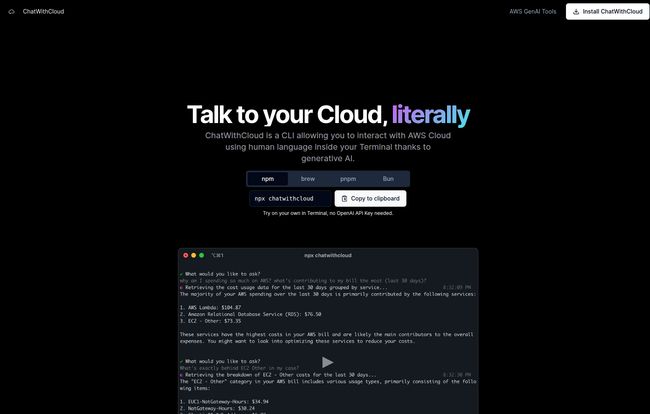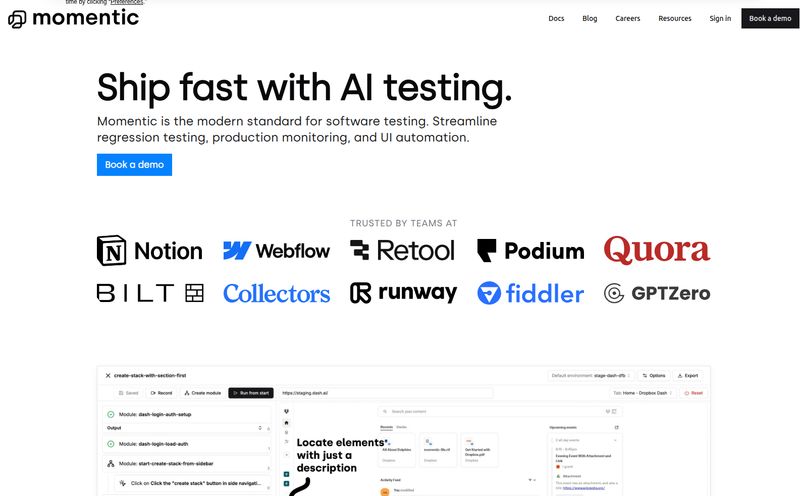Let’s have a little heart-to-heart. If you’ve spent any serious time in the trenches with Amazon Web Services, you know the love-hate relationship with the AWS Command Line Interface (CLI). It’s powerful. It’s a beast. It lets you orchestrate entire empires from a tiny blinking cursor. But good heavens, the syntax. Trying to remember the exact flag for filtering instances by tag, then querying a specific output, and formatting it as text... it’s like trying to recite an ancient incantation. You get one syllable wrong, and the spell just fizzles.
I’ve been there. We’ve all been there. Hunched over, squinting at documentation, cobbling together a command that’s longer than my weekly grocery list. So when I stumbled upon a tool called ChatWithCloud, the promise was just too good to ignore: “Talk to your Cloud, literally.”
My inner cynic, honed by years of overhyped MarTech and vaporware, immediately scoffed. “Sure,” I muttered. “Another AI gimmick.” But my inner, overworked DevOps guy was intrigued. What if... what if it actually worked? What if I could just type what I wanted and have it happen? I had to find out.
So, What is ChatWithCloud Anyway?
At its core, ChatWithCloud is a CLI tool that you install on your machine. But it’s not just another CLI. It’s a translator. A bridge. It sits in your terminal and uses generative AI to convert your plain-English requests into actual AWS CLI commands and API calls. You ask a question, it figures out the arcane AWS-speak, runs the command for you, and gives you a clean, human-readable answer.
Think of it as the universal translator from Star Trek, but for cloud infrastructure. It’s for those of us who live and breathe in the terminal but are getting a bit tired of memorizing the dictionary.

Visit ChatWithCloud
The Features That Genuinely Made Me Pause
A features list is just a list. What matters is what it solves. And ChatWithCloud seems to be targeting some of the most persistent aches and pains of managing an AWS account.
Cost Analysis Without the Migraine
The AWS Cost Explorer is a powerful tool, but it can feel like you need a degree in data science to get a simple answer. I’ve lost hours clicking through filters and charts. With ChatWithCloud, the idea is you can just ask:
What were my most expensive services last month?
List all EC2 instances that aren't tagged with 'Project'.
Show me the total cost of my S3 buckets in us-east-1.
That last one is a godsend. Chasing down untagged resources that are slowly draining your budget is a monthly ritual for many of us. Automating that with a simple question is, frankly, a huge win.
Security Audits on the Fly
Security is another area where complexity can be the enemy. An overlooked setting can leave a massive hole in your defenses. I was particularly interested in how ChatWithCloud handles this. The promise is the ability to ask things like:
Are any of my S3 buckets public?
Find security groups that allow inbound traffic from 0.0.0.0/0 on port 22.
List IAM users who haven't enabled MFA.
Running these checks manually can be a real chore. Being able to do it with a quick, conversational query from the command line? That lowers the barrier to performing regular security checks, which is always a good thing.
Troubleshooting and Actually Fixing Stuff
Okay, this is where my eyebrows really shot up. The tool doesn't just diagnose problems; it suggests and can even execute fixes. The example on their site shows it finding an issue and then asking, “Do you want me to fix this for you?”
This is both amazing and slightly terrifying, right? It’s like having a junior engineer on call 24/7. You can ask, “Why can’t my EC2 instance connect to the internet?” and it might come back with, “The instance is in a subnet with no route to an Internet Gateway. I can add one for you.”
In my experience, this is the real game-changer. It’s not just about getting data; it’s about taking action. It turns the tool from a fancy reporting dashboard into an interactive assistant. I wouldn't let it redesign my VPCs, but for fixing common, well-understood problems, its a massive time-saver.
Let's Talk Money: The ChatWithCloud Pricing Breakdown
Alright, so how much does this magic cost? They've gone with two pretty straightforward models, which I appreciate. No confusing tiers or per-seat licenses that require a spreadsheet to understand.
There is a Lifetime License, which they call the "Early believer plan." For a $39 one-time purchase, you get the tool forever. The catch? You have to bring your own OpenAI API key. This is the perfect deal for tinkerers and power users who already have an OpenAI account and are comfortable managing their API usage. It's a bet on the tool's longevity for a very reasonable price.
Then there's the Managed Subscription. This is $19 per month and is the “easy button” option. You get unlimited usage, and you don’t need to worry about providing an API key—all the generative AI costs are handled by them. They also state this plan uses a "smarter model & better responses," which suggests they might be using a more powerful or fine-tuned version of the AI for their subscription customers. This makes sense for professionals or teams where a predictable monthly cost and zero setup friction are more valuable.
My Honest Take: Who Should Use This?
After playing around with it, I have some opinions. This tool is NOT for someone who is brand new to AWS. If you're just learning, you need to struggle with the regular CLI and the AWS Console. You have to understand the underlying concepts before you can effectively use an abstraction layer like this. Using ChatWithCloud too early would be like learning to drive in a self-driving car—you'd never really learn the rules of the road.
However, for the seasoned professional? The DevOps engineer, the SRE, the senior developer who knows what they want to do but can't be bothered to look up the syntax for the umpteenth time? This tool is a productivity multiplier. It's for the person who needs to quickly diagnose a production issue at 2 AM and doesn't want to fight with command flags.
It's a sharp, clever application of AI that solves a real, nagging problem. It’s not going to take your job, but it might just make it a little more pleasant.
Frequently Asked Questions about ChatWithCloud
How does ChatWithCloud actually work?
It connects to your AWS environment using the credentials you've already configured for the standard AWS CLI (it respects your `~/.aws/credentials` file). When you type a command in plain English, it sends that request to a powerful generative AI model, which translates it into the appropriate AWS API call or CLI command. It then executes that command and formats the output for you.
Is it secure to let an AI manage my AWS account?
This is a valid concern. The tool operates with the same permissions as your configured AWS user or role. The best practice is to always follow the Principle of Least Privilege. Run the tool with an IAM role that only has the permissions it needs to do its job. Don't run it with your root account! The security is ultimately still in your hands, the tool is just an interface.
Is this better than Amazon Q or other AWS AI tools?
It's different. Amazon Q is more deeply integrated into the entire AWS ecosystem, including the console, IDEs, and more. ChatWithCloud is a lean, mean, command-line-focused tool. It's less of an all-encompassing platform and more of a sharp utility for people who prefer working in a terminal. I'd say they solve similar problems but for slightly different workflows and user preferences.
Can it only read data, or can it make changes?
It can do both. It can read data (like listing S3 buckets) and it can modify your infrastructure (like fixing a routing issue). It will typically ask for confirmation before making any changes, which is a crucial safety feature.
What's the deal with bringing my own OpenAI key for the lifetime license?
When you use the lifetime license, the tool makes API calls to OpenAI on your behalf to process your natural language commands. These calls consume tokens, which you pay for directly through your OpenAI account. It offers flexibility but means you're responsible for the usage costs. For light to moderate use, this is often very inexpensive.
The Final Verdict
I came in skeptical, and I'm walking away impressed. ChatWithCloud isn't a revolution that will change the fabric of cloud computing. What it is, though, is an incredibly practical, well-designed tool that smooths out one of the roughest edges of the daily AWS grind.
It's a testament to the idea that the best AI applications aren't always the biggest or most dramatic, but the ones that give us back our most valuable resource: time. For a one-time fee of $39 or a small monthly subscription, it has the potential to save hours of frustrating documentation-diving and command-line wrestling. In my book, that's a pretty fantastic deal. It's earned a spot in my terminal, and I'm genuinely excited to see where it goes from here.



